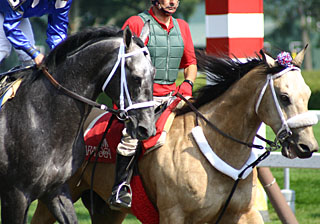Equine Health Research
The J.D. Wheat Veterinary Orthopedic Research Laboratory is the leader in advancing knowledge of equine musculoskeletal problems. It houses state-of-the-art equipment and fosters a creative environment for basic and clinically applied equine musculoskeletal research. Under the directorship of Dr. Susan Stover, a former trainee of Dr. Wheat, faculty work in collaboration with other clinicians and scientists to continue improving our understanding of equine musculoskeletal diseases.
The group has authored multiple publications over the last decade, trained numerous graduate students, clinical residents, visiting fellows and veterinary students. In addition to presentations at scientific meetings, the group has made numerous presentations to industry and written articles for horse owners and trainers.
Funding support for the laboratory is derived from competitive granting agencies, research sponsors and industry friends. In 1997, a major gift from the Dolly Green Foundation ensured, in perpetuity, the laboratory's future and further increased its competitiveness for sponsored research that directly benefits the equine industry.

Continuing Education
Using the research and findings from these programs a comprehensive education program designed to educate licensees is being developed for injury prevention in equine athletes. Training materials contain an overview, interactive information, how to movies, and self-assessment sections.
Major Accomplishments that have Benefitted Racing
- Discovered stress fractures precipitate catastrophic fractures
- Discovered new sites, now routinely examined, for stress fractures
- Advocated bone scan (scintigraphy) installation at Santa Anita Racetrack
- Developed new bone scan views to enhance detection of stress fractures
- Associated high intensity exercise with increased risk for skeletal injury
- Determined high intensity exercise increases risk for layup
- Determined that layup increases risk for catastrophic humeral fracture
- Associated horseshoe toe grabs with increased risk for injury, especially suspensory apparatus failure (fetlock breakdown)
- Discovered osteoarthritis in the back and pelvis of over 25% of racehorses that die for other reasons
- Developed new, improved techniques for sampling and treating the fetlock and pastern joints
- Improved methods for fracture repair (tibia, pastern)
- Improved understanding of joint cartilage inflammation and function
Current Goals of the Equine Research Program
- Determine the effects of layup on bone and tendon function
- Elucidate the events leading to cannon bone condylar fracture and fetlock joint osteoarthritis
- Determine the effect of hard and soft racetrack surfaces on tendon function
- Develop a dynamic computer simulation of the horse's forelimb during racing - for the future study of interaction of racetrack surface characteristics and hoof/shoe conformation with risk for tendon and suspensory ligament injuries (tendinitis, bowed tendons and fetlock breakdown)
- Determine training regimes to minimize injury
- Determine rehabilitation regimes to optimize return to training and prevention of re-injury
- Enhance repair methods for major bone fractures
Interface Between the Racetrack and the Racehorse
(see more on Footing and Race Surfaces)
The racetrack surface is one of the most frequently blamed factors for racehorse injuries. It is also one of the most manageable factors. The J.D. Wheat Veterinary Orthopedic Research Laboratory has plans for a multi-faceted program for the study of the effect of racetrack surface and horseshoe characteristics on the likelihood for suspensory ligament and tendon injury. Our approach combines: 1) an epidemiologic study of horseshoe characteristics and non-fatal injuries, 2) development of an improved instrumented horseshoe for measurement of the complete loading profile on the hoof on different racing surfaces, and 3) development of a computer simulation of a racing horse's forelimb for the evaluation of tendon and ligament strain (propensity for injury) relative to different racing surface characteristics and horseshoes. A gift dedicated to these programs would be focused on developing racetrack surfaces and horseshoes for the prevention of injury, and perhaps, even increasing performance as noted by race times.
Equine Limb-Surface Interaction Computational Model
Access zip files to run the SIMM model.
Training and Rehabilitation for the Prevention of Injury and Re-injury
(see more on Racehorse Injury)
Perhaps the most under served aspect of equine sports medicine is training for injury prevention and rehabilitation. Tremendous advances have been made in diagnostics, surgical and anesthetic techniques, and pharmaceutics, but little has been done to advance methods for injury prevention and speeding convalescence or for optimizing return to athletic activity.
Racehorse training programs are firmly set in tradition. There is little scientific basis for recommendations for training methods, the length of layup periods after injury, or rehabilitation and retraining programs. Epidemiologic studies conducted in the JD Wheat Veterinary Orthopedic Research Laboratory have demonstrated the important interrelationships between training intensity, lay-up time, and risk of injury. As this knowledge base grows for different injury types, it will be critical to develop scientifically sound training and rehabilitation approaches for use during convalescence and return to training. The comprehensive approach possible through the resources of the JD Wheat Veterinary Orthopedic Research Laboratory and the Equine Athletic Performance Laboratory at the School of Veterinary Medicine at UC Davis and the close collaboration with the racing industry offers a unique opportunity to develop innovative solutions in rehabilitation.
The Opportunities Ahead
Great strides have been made in discovering the causes of catastrophic injury in racehorses, understanding the events leading to bone fracture, enhancing techniques to detect stress fractures in live horses, identifying exercise factors that place horses at increased risk for catastrophic injury, and providing horseshoe recommendations to prevent suspensory apparatus injury. But the challenge continues in order to make horse racing a safe sport for horse and man.
Opportunities are ripe for advancement. Our focus on factors that can be managed by the industry will greatly facilitate implementation and change for injury prevention.
These factors include:
- Racing surface and horseshoe interface
- Training and rehabilitation regimes
- Integrative methods of treatment
If you are interested in supporting programs and research activities related to the equine research program, please Dr. Sue Stover at smstover@ucdavis.edu.
